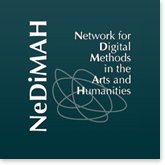 The project objective is to develop an ontology of digital research methods in the arts and humanities, by advancing the state of the art established by earlier initiatives in the field of digital research methods formal representation work, such as manifested in the AHDS digital research methods taxonomy , the Oxford methods taxonomy, the methods taxonomy/ontology currently under development by DARIAH-DE, as well as the information organization schemes applied in the DHO, arts-humanities.net and DH-Commons portals.
The project objective is to develop an ontology of digital research methods in the arts and humanities, by advancing the state of the art established by earlier initiatives in the field of digital research methods formal representation work, such as manifested in the AHDS digital research methods taxonomy , the Oxford methods taxonomy, the methods taxonomy/ontology currently under development by DARIAH-DE, as well as the information organization schemes applied in the DHO, arts-humanities.net and DH-Commons portals.
The outcome of the project will be an ontology delivered in both document and machine readable forms, and a Web service comprising a database containing the ontology definition and the appropriate functionality to support access to and evolution of the ontology.
The ontology will be an explicit specification of a shared conceptualization of digital research methods and their context of scholarly use. It includes types of objects and/or concepts, and their properties and relations, which can be used to adequately represent the domain of arts and humanities scholarly practice in the digital age. The scope of abstract entities encompassed by the methods ontology may include classifications of scholarly disciplines and fields, methodologies, theoretical approaches, research techniques, procedures, research data and resources, epistemic objects, research actors, as well as research environments, mechanisms, tools, systems, services, and infrastructures. Entities representing particulars, such as concrete digital methods, research procedures, and tools, will be defined on the basis of the specification of abstract entities, the property slots employed for their definition, and the relations between them. In this framework accounts of empirically attested scholarly practice, such as the use of a particular research method by a specific digital humanities research project to process a dataset or body of scholarly evidence into an interpretive model, syllogism, or publication, will be represented as instances of relevant entities and properties of the ontology. In terms of structure, the ontology will comprise a basic network of concepts associated with various semantic relations and a number of taxonomies capturing systematic specialisations of those concepts and relations. This formalization assures that the ontology will adhere to principles of scientific rigour, and it will be amenable to operationalization, e.g. to produce a schema for systems such as digital research practice portals, and methods and tools registries.
The ontology definition will include scope notes for entities and properties, hierarchy links and examples. In machine readable form, the ontology will be defined in RDF/S (RDF Schema), in order to support its use in a wide range of applications accessing registries and knowledge bases that contain information about methods and their context of use. Furthermore the taxonomic parts of the ontology will comply with SKOS (Simple Knowledge Organization System). Finally compliance with the ISO standard 21127 CIDOC CRM will be ensured.
Maintenance and further development of NeMO will be carried out by DCU within DARIAH-GR and will be contributed to DARIAH-EU.